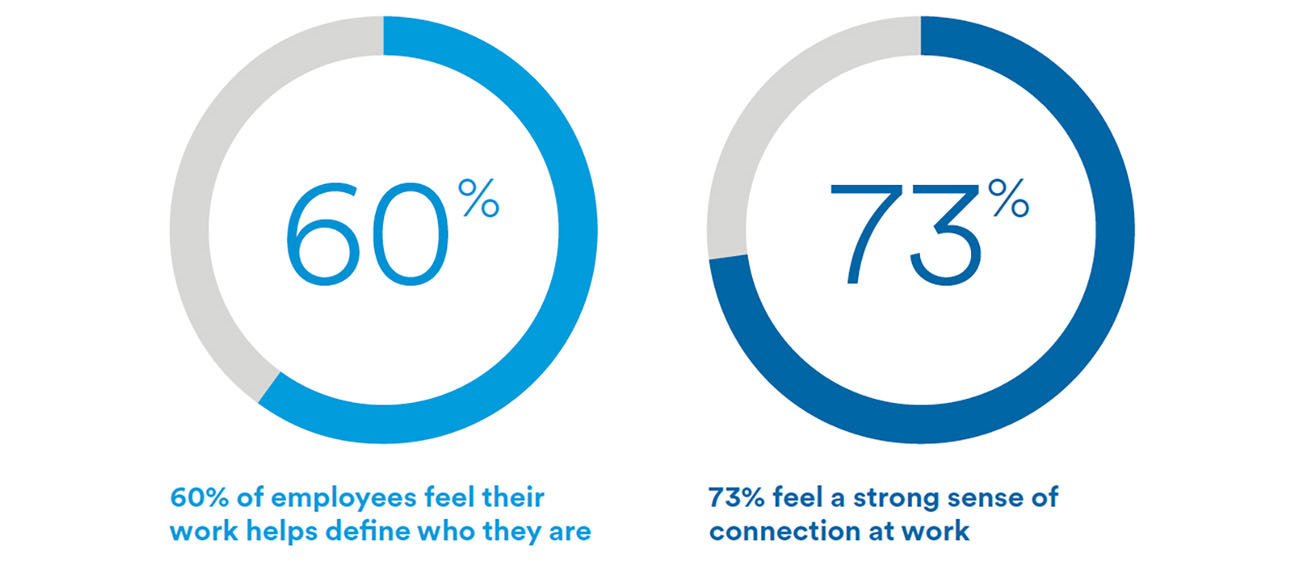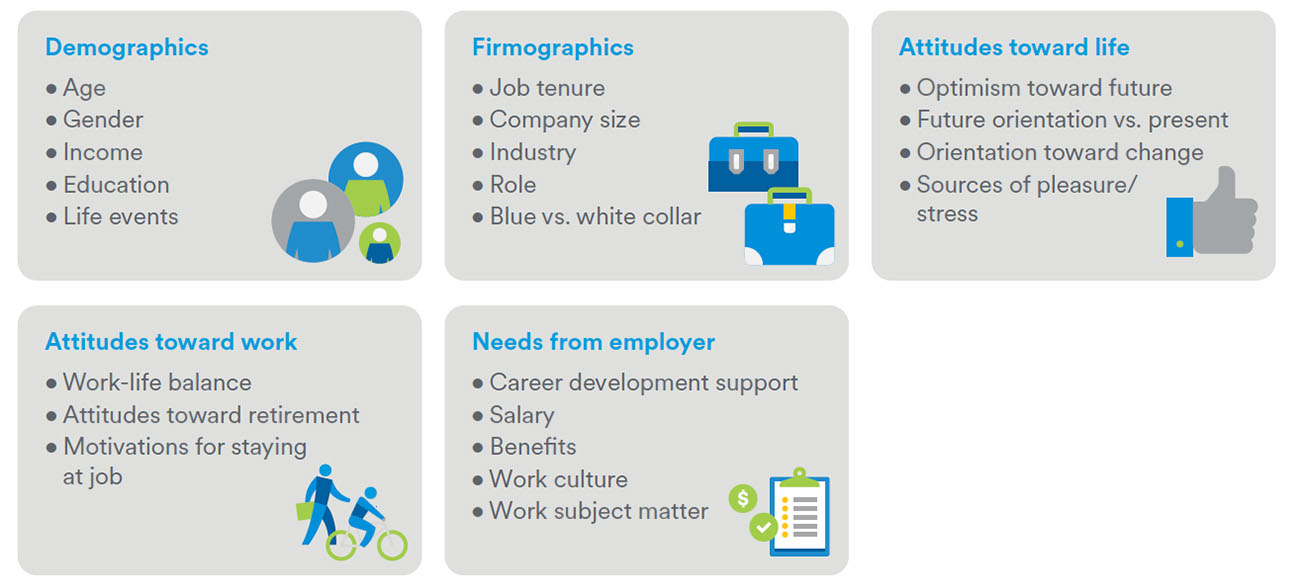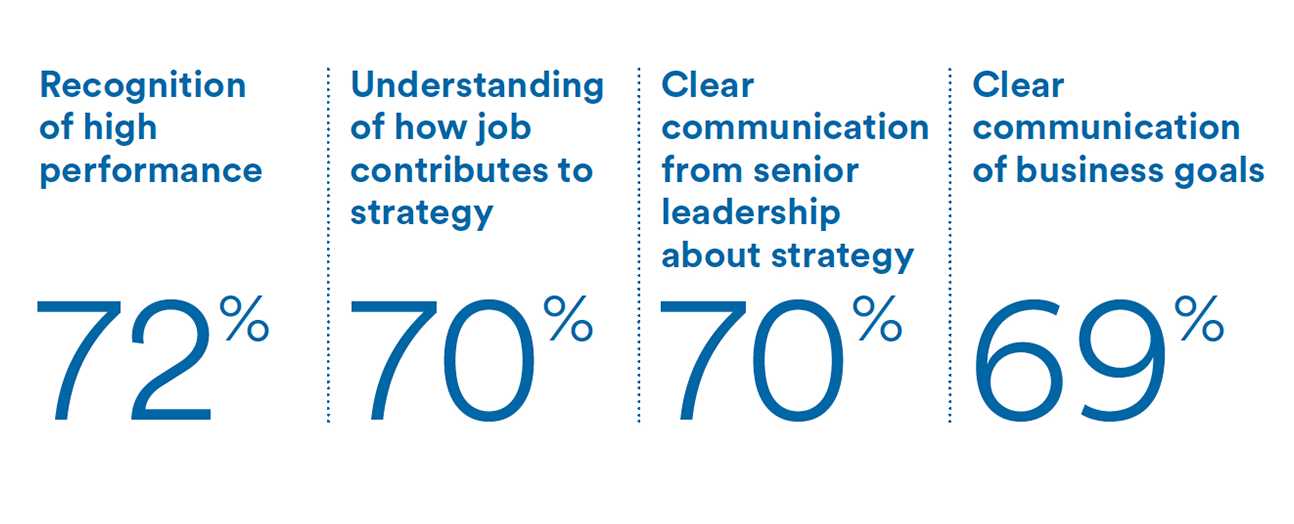Building stronger engagement through employee segmentation
Traditional ways of analyzing employee groups are no longer relevant. Assessing employees based solely on their demographics is keeping employers from understanding the most important motivations that drive employee satisfaction. The world’s leading companies are using a different approach. This is a new kind of segmentation that uncovers employees’ preferences, motivations, personal goals and individual circumstances. A new brand of segmentation that allows HR to better focus their limited resources on what will have the most impact on their unique employee populations.
1. Seeing employees differently
For today’s employees, work isn’t just a way to pay the bills. In a world of record employment rates, changing attitudes and on-demand everything, employees are expecting more. They want work that enriches their personal lives, and their personal lives enriched by what they do every day. They want work with meaning, and they want to work in a place that they feel comfortable bringing their whole selves to the job.
The personal importance of work to employees1
 |
Today’s employees want to be seen and respected as individuals, each on their own journey, each facing different realities: single parents, college graduates still in debt, artists working to support their dream, and career-minded traditionalists. But many employers still see employees based on blanket demographics. Age, gender and job title don’t tell you about career motivations or personal passions. Classic demographic descriptions do little to reveal the needs of diverse individuals, each pursuing their own path.
Employers want engaged employees. They’re more productive, more effective and they create a less stressful work environment. And they have an impact on the overall success of the business.
Importance of employee engagement to senior executives2
 |
2. A better way to segment employees
 |
Moving from basic demographics and life stages to a view based on mindsets and attitudes isn’t new. Every day we all are plugging in information to various platforms, commenting, liking and posting; filling out surveys and defining our preferences. But using this approach to better understand employees is a shift. When done right, it gives top companies a new way to tap into the mindsets and attitudes of customers that is more personalized, customized and authentic. Harnessing this data allows industries to approach their customers differently, interact with them based on their preferences and keep them engaged by staying aware of their needs. Seeing employees in a similar way allows us to better meet their needs in the work they do.
Imagine a company that doesn’t expect its largely Millennial workforce to care about retirement. Using the broad demographics of age and life stage, this company might assume Millennials don’t want to put their money into a market they saw collapse in 2008 and aren’t really thinking about the future anyway. But painting with such a broad brush doesn’t capture what we actually know about the Millennial generation. In fact, many Millennials are quite concerned with their future finances, and retirement as well as other benefits absolutely matter to them. Segmentation based on attitudes and mindsets challenges core assumptions about what we think we understand about employees today.
3. Insights for engagement
MetLife conducts extensive research on the modern workforce. We look at how employees view the workplace, what they want to accomplish in their jobs and what they want and expect from their employers. We look at a variety of variables ranging from the basics of age and education to the nuances of employees’ goals, aspirations and reasons for remaining at work.
Factors in employee segmentation
 |
Using this data, MetLife is able to paint a detailed picture of specific employee segments. We see clear distinctions between employees’ approaches to finding ways for work and life to enrich one another; from seeing work as a means to personal fulfillment to seeing work as a means to support their personal goals.
But understanding employees is only the beginning. With this knowledge comes the power to optimize programs that better fit the needs and goals of employees. It allows employers to develop new initiatives that embrace the individual circumstances of more employees. Using this kind of segmentation allows HR to focus dollars where they’re most impactful, because they know these programs have a direct emotional link to employee satisfaction.
Drivers of employee engagement that segmentation can help with:3
 |
4. Tools you can use
MetLife’s employee segmentation research is being put to work now, helping HR leaders select their benefits, communicate product features more effectively, adjust current programs to suit their diverse employees, and help employees understand they can get the most out of the benefits they have. It’s helping employers increase and enrich the quality of employees’ connection to their work and their companies.
Our team can work with you to activate segmentation insights that fit your needs, learn more about your workforce, and help optimize engagement and retention.
Contact MetLife today to learn more about how we can help you better understand and engage your unique workforce.